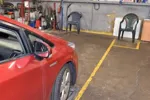What is meant by that exactly will trickle down to dealer groups shortly, but it is clear that the ex-Airbus chief executive intends to manage the whole business from raw materials to final customer rather than just manufacturing strategy.
The good news is that this assertiveness comes with “autonomy” for the dealers and a programme of “motivation”.
Streiff has been running a complete review of operations and the conclusions are now getting signed off for action.
The press conference was the first briefing both for staff and the outside world.
First there will be a programme to broaden the base of the sibling brands by driving them further apart and covering more ground.
“The objective is to target different customers for Peugeot and for Citroën.”
They will also compete with one another in the way that other volume brands compete with them. Differentiation will have to be continuous to get the “most innovative and widest line-up in Europe.”
He recognises that different markets need different strategies and never more so than in the fleet business. UK fleet sales are to be developed fast.
“We must expand our presence in the corporate fleet markets and to do that we must protect the resale value, and refine the distribution and marketing process.”
Within the retail networks there are going to be centres of excellence, specialist staff, dedicated spaces for specialist vehicles and cars that are highly distinctive.
The green sheen will be reflected in micro car hybrids with stop-and-start technology, mild hybrids ready by 2010, and 30% of the line-up available with bio-diesel.
Streiff acknowledges that quality has been an issue and wants warranty halved within three years and the fault resolution time down by two-thirds in the same period.
There is to be a torrent of model renewals – 29 over the next three years compared with 22 over the last three. Average age of the cars in the line-up will drop to 3.2 years from the 4.2 years of 2006.
Like Renault, PSA wants a big step up in sales and is targeting four million cars by 2010, which means a 20% increase. Half of that will be from regaining market share in Europe. The rest will come in Russia, China and South America.














Login to comment
Comments
No comments have been made yet.